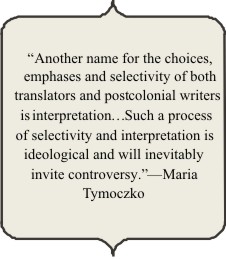| |
Post colonial literature and translation
There are critics who have pointed out the commonalties between translations and postcolonial literature. In fact, the colony was thought of as a copy or translation of the ‘great European original' ( Postcolonial Translation : 4). Maria Tymoczko points out that translation can be perceived as a metaphor for post-colonial (19). She goes to the etymology of the word ‘translation' as ‘carrying across', or as the transportation of sacred relics like the bones of saints, and notes how it has much in common with the linguistic activity of translation. A ‘minor' literature of a former colony is written/ carried across in another language to a more secure place or centre of power – think of Indian literature written in English for an international readership. Isn't this also a form of translation? Like translation, postcolonial literature also straddles two cultures, but the difference is that the translator's domain is limited to one text whereas the writer's domain is the vast area of her / his cultural context. S/he has to capture all of it in her writing for an international readership. In this process, s/he is free to choose what s/he will represent. The translator, bound to one text, does not have the same range of choice.
Both the postcolonial writer and the translator are addressing an intercultural audience, and are trying to convey material from one culture or language to another. Hence these cultural differences have to be bridged. The translator has recourse to footnotes, glossaries and prefaces to help fill the void between the source language and target language. This does not appear to be the privilege of the creative writer, but it can be seen as part of the narrative strategy of many postcolonial novels. For example, in Amitav Ghosh's The Hungry Tide, Nirmal's diary is used as a tool to introduce the reader to the terrain of the Sunderbans. This introduction is necessary, as this part of the country is relativ ely unknown to even the Indian reader. Rather than write a preface that might go unread, Ghosh has made it an integral part of the novel by making the central character Kanai read his uncle Nirmal's diary in the first chapter. However, there are writers who deliberately disrupt the narrative and provide maps and footnotes; this is in keeping with postmodern narrative strategy. ely unknown to even the Indian reader. Rather than write a preface that might go unread, Ghosh has made it an integral part of the novel by making the central character Kanai read his uncle Nirmal's diary in the first chapter. However, there are writers who deliberately disrupt the narrative and provide maps and footnotes; this is in keeping with postmodern narrative strategy.
The postcolonial writer has a vast cultural space to represent through her/his work. The inclusion of some elements would automatically exclude certain others. This is somewhat like the translator who has to decide which elements of the source text s/he will downplay for the benefit of the receptor readership. This process of selection in writing, and interpretation in translation, are politically or ideologically nuanced. Aravind Adiga's selection of one aspect of contemporary India , that of the gaping chasm that separates the rich and the poor even in the so-called ‘postmodern' India, in his novel The White Tiger is very much a political decision. His aim is to subvert the image of India as a progressive country on the rise to economic superpower. Similar ideological choices lie behind the decision of a translator to choose a particular text, and translate it as s/he deems fit for the receptor culture. |